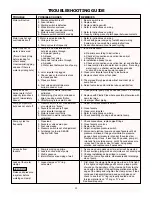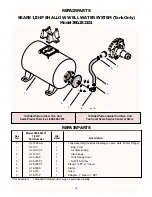
Disconnect power at service panel
before connecting pressure switch.
Figure 4 – 115/230 volt motor wiring connections
through typical pressure switch.
Dual voltage motors come factory wired for 230
volt operation. Inset shows 115 Volt conversion.
Do not alter wiring in single voltage motors.
Match motor voltage to power supply voltage.
Risk of serious or fatal
electrical shock.
Connect motor ground
wire before connecting
power supply wires.
Do not ground to a gas sup-
ply line.
Turn off power before
working on pump or
motor.
Match motor voltage and power supply voltage.
Supply
voltage must be within ±10% of motor nameplate voltage.
Incorrect voltage can cause fire or seriously damage motor
and voids warranty. If in doubt, consult a licensed electri-
cian.
Use wire size specified in wiring chart.
If possible, con-
nect pump to a separate branch circuit with no other appli-
ances on it.
1.
Install, ground, wire and maintain pump in accordance
with your local electrical code and all other codes/ordi-
nances that apply. Consult your local building inspector
for code information.
2.
Connect ground wire first as shown at left. Ground wire
must be a solid copper wire at least as large as power
supply wires.
• There must be a solid metal connection between
pressure switch and motor to provide motor ground-
ing protection. If pressure switch is not connected to
the motor, connect ground screw in switch to motor
ground screw. Use a solid copper wire at least as large
as power supply wires.
• Connect ground wire to grounded lead in service
panel, metal underground water pipe, well casing at
least 10’ (3M) long, or to ground electrode provided
by power company.
3.
Connect power supply wires as shown at left.
4.
Replace pressure switch cover before turning on power
to pump.
ELECTRICAL
OPERATION
Priming the Pump
NOTICE:
To properly prime the pump, install a pipe
tee in the discharge piping (see Figure 1A, Page 3).
To prevent damage to internal parts, do not start motor
until pump has been filled with water.
To prime pump:
1. Remove priming plug (Purchase separately; Figure
1A, Page 3).
2. Fill pump with water.
3. Replace priming plug, using Teflon tape or Plasto-
Joint Stik
2
on plug threads; tighten plug.
4. Start the pump. Water should be pumped in 1-2
minutes. If not, repeat steps 1, 2 and 3.
On shallow depths to water (10 feet or less), the
pump will probably prime the first time after the
following steps 1 through 4 above.
From 10 to 20 foot depths, you might have to shut
off the pump and repeat steps 1, 2 and 3 several
times.
5. If, after priming pump several times, no water is
pumped, check the following:
A. Be sure suction pipe is in the water.
B. Be sure suction pipe does not leak.
C. Be sure that pump is not trying to lift water too
high (see “Piping in the Well”, Page 4).
D. As long as foot valve and check valve function
correctly and suction pipe does not develop
leaks, pump should not need repriming in nor-
mal service.
2
Lake Chemical Co., Chicago, Illinois
6
A
B
L2
L1
A
B
L2
L1
To convert from
230 to 115 Volts:
Move white wire
w/black tracer
from B to A.
Move black wire
from A to L1.
A
B
L2
L1
A
B
L2
L1
Clamp
power
cable to
prevent
strain on
terminal
screws.
White w/
Black Tracer
Black
Motor Ground
Screw
Connect green (or bare copper) ground
wire to green ground screw.
Motor wires
are connected
to these two
brass screws.
2263 0196
Connect black and white power supply
wires to these two screws, one wire
to each screw. It doesn't matter which
wire goes to which screw.
Your pressure switch may look like this.
If so, connect the black and white power
supply wires to the
outside
terminals.
Motor wires are connected to the two
center
terminals.
Connect green (or bare copper) ground
wire to green ground screw.

































